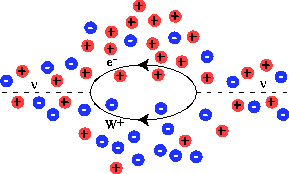Neutrinos are involved in the explosion of stars, called supernovae. While Stephen Hardy has shown that generation of plasma waves by the neutrinos is unimportant, Malcolm Kennett has discovered an asymmetry in the neutrino interaction with a superstrong magnetic field, which may ultimately explain the high velocities of some pulsars through the Galaxy.
Neutrinos were postulated in the 1930s as particles with no mass and no electrical charge that carry off energy in the decay of the neutron. Several decades elapsed before the first direct evidence for neutrinos, and relatively soon thereafter, they were detected from the Sun. Neutrinos were also detected from a supernova (SN1987A) in a nearby galaxy, confirming ideas on the important role played by neutrinos in supernova explosions.
Neutrinos in a plasma have a very small induced charge associated
with them and a corresponding very small induced current. These
electromagnetic properties arise through the effect of interactions
involving the weak nuclear force. According to standard quantum
mechanical ideas, a neutrino spends part of its time as a
combination of virtual particles which exist only briefly. One of
these virtual particles is an electron and the other is a W ![]() boson. When a neutrino moves through a plasma, these virtual
particles are influenced by the charged particles in the
plasma. This can lead to a kind of shielding of the virtual
charges, the effect of which is analogous to the Debye shielding in
an electrolyte. Debye shielding depends on the charge to mass ratio,
which is different for the virtual electron and the virtual W
boson. When a neutrino moves through a plasma, these virtual
particles are influenced by the charged particles in the
plasma. This can lead to a kind of shielding of the virtual
charges, the effect of which is analogous to the Debye shielding in
an electrolyte. Debye shielding depends on the charge to mass ratio,
which is different for the virtual electron and the virtual W ![]() boson. The resulting very small charge inhomogeneity in the plasma
associated with the shielding of the virtual particles moves with
the neutrino and gives it its induced electromagnetic properties.
boson. The resulting very small charge inhomogeneity in the plasma
associated with the shielding of the virtual particles moves with
the neutrino and gives it its induced electromagnetic properties.
During 1997, Malcolm Kennett extended the work on neutrinos begun by Stephen Hardy (reported in the 1996 Annual Report) to include the effect of a superstrong magnetic field. The magnetic field does not affect the neutrinos directly, but it has a significant effect on the Debye shielding. However, the most surprising effect identified by Malcolm arises from the fact that the weak interactions, unlike the other basic laws of physics, have a particular handedness: there are left-handed but not right-handed neutrinos. The weak interactions may be separated into a reflection symmetric, or `vector' part, and a reflection asymmetric or `axial vector' part. There is no coupling between the axial vector part and the plasma under most circumstances, because a plasma has no preferred handedness. However, in a superstrong magnetic field, most of the electrons can be in their ground state which, unlike all other states, does have a preferred handedness. There can then be a significant coupling between the axial vector part of the neutrino interaction and the plasma. A possible astrophysical implication is that this coupling can lead to an asymmetry in a supernova explosion, associated with the polarity of the magnetic field in the source region of the neutrinos. Only a small asymmetry in the neutrino emission is required to give the neutron star formed in the explosion an impulsive kick large enough to explain the high observed velocities through the Galaxy of some pulsars.
A cartoon of a neutrino spending part of its time as a combination of a virtual electron and W ![]() . The electron and W
. The electron and W ![]() attract oppositely-charged plasma particles (for clarity color-coded blue for negative, red for positive), resulting in a very small charge inhomogeneity in the plasma.
attract oppositely-charged plasma particles (for clarity color-coded blue for negative, red for positive), resulting in a very small charge inhomogeneity in the plasma.
